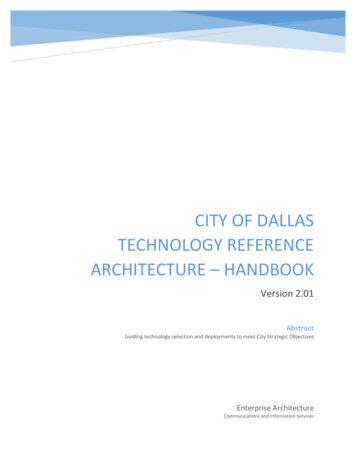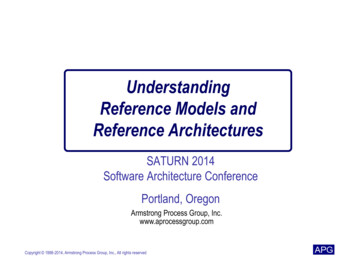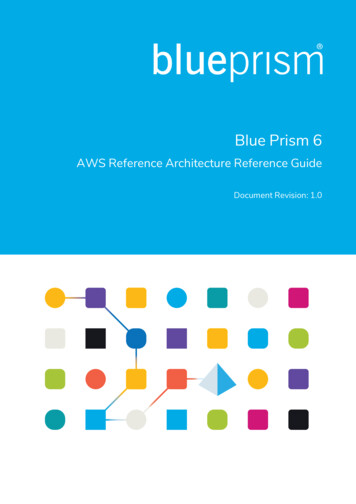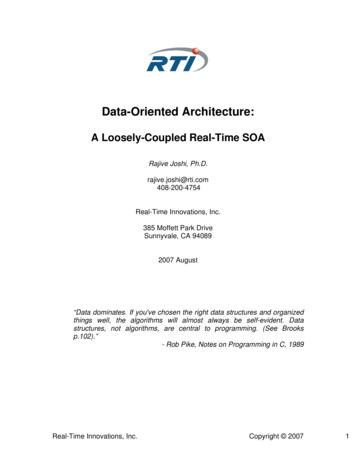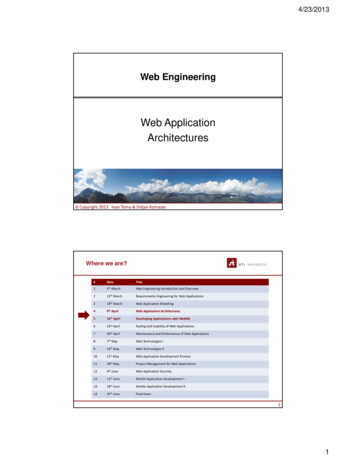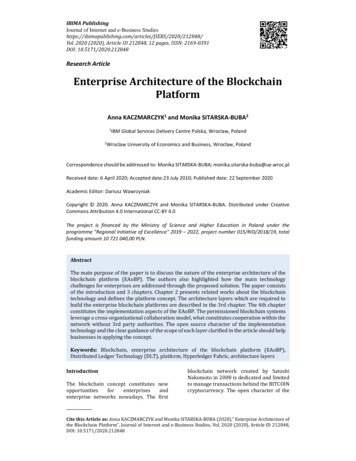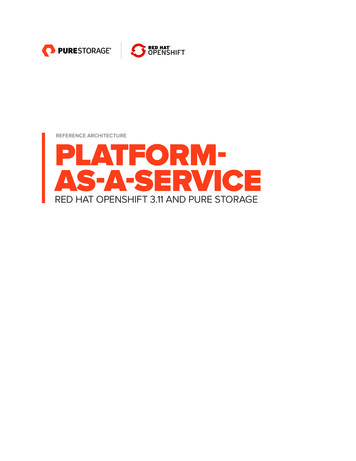
Transcription
REFERENCE ARCHITECTUREPLATFORMAS-A-SERVICERED HAT OPENSHIFT 3.11 AND PURE STORAGE
TABLE OF CONTENTSINTRODUCTION . 4PLATFORM-AS-A-SERVICE . 4PaaS Defined . 4Requirements of a PaaS Platform . 5PaaS – Bare Bones . 6COMPONENTS, PRE-REQUISITES, AND CONFIGURATION . 7Pure Storage FlashArray . 7Pure Storage FlashBlade . 9Pure1 . 11Evergreen Storage . 11Red Hat OpenShift for Containers . 12Pure Service Orchestrator . 12High-Level Design . 13Software Version Details . 14Compute . 15Networking . 15DEPLOYMENT . 16Pure Storage Red Hat Best Practices . 16Configuring Docker Storage . 16Configure Docker Registry Storage . 17PERSISTENT STORAGE . 19Pure Service Orchestrator Installation . 19SIMPLE POD DEPLOYMENT WITH A PURE STORAGEFLASHARRAY PERSISTENT VOLUME . 23Persistent Volume Claim . 23Application Pod . 252
SIMPLE MULTIPLE POD DEPLOYMENT WITH A PURE STORAGEFLASHBLADE PERSISTENT VOLUME . 28Persistent Volume Claim . 28Ensure NFS Write Access . 29Application Pod . 30Additonal Application Pod . 31UPDATING PURE SERVICE ORCHESTRATOR CONFIGURATION . 33ADDING CLUSTER NODES TO OPENSHIFT . 34CONCLUSION . 35APPENDIX 1: ANSIBLE DEPLOYMENT INVENTORY . 36APPENDIX 2: OPENSHIFT CATALOG TO DEPLOY SIMPLE APPLICATIONS . 37APPENDIX 3: OPENSHIFT DEPLOYMENT LINKS . 43ABOUT THE AUTHOR . 443
INTRODUCTIONThis document provides a practical reference architecture to help integratePure Storage products into the deployment of a Red Hat OpenShift ContainerPlatform. The underlying infrastructure for this platform will be based on a baremetal deployment that can be scaled easily to whatever size is required. It isassumed that the reader understands how to deploy a bare-metal OpenShiftsolution, as details will only be provided for the Pure Storage integration pieces.Links to details on OpenShift deployments can be found in the Appendix ofthis document.PLATFORM-AS-A-SERVICEPaaS DefinedCloud computing has widened its scope to include platforms for developing and implementing custom applications,a term called “Platform as a Service” (PaaS). PaaS applications are also suggested as on-demand, web-based, orSoftware-as-a-Service (SaaS) options. However, a comprehensive definition is:Platform as a Service (PaaS) is the delivery of a computing platform and solution stack as a service. PaaSofferings facilitate deployment of applications without the cost and complexity of buying and managing theunderlying hardware and software and provisioning hosting capabilities, providing all of the facilities requiredto support the complete life cycle of building and delivering web applications and services entirely available onthe Internet.PaaS offerings may include facilities for application design, application development, testing, deployment, andhosting. This includes the scope of application services such as team collaboration, web service integration andmarshalling, database integration, security, scalability, storage, and developer community facilitation, amongothers. These services may be provisioned as an integrated solution offering over the web.In simple terms, PaaS provides a runtime environment for cloud applications. It refers to the almost negligible need tobuy standalone software, hardware, and all related services, since these are available on the Internet in a more “publiccloud” manner. In a private cloud setting, one would still need to buy hardware and software to build the infrastructure,but PaaS will help manage and utilize it in a manner that meets cloud standards. In the next section, we will discuss thecloud standards that any PaaS platform must implement. Additionally, in private cloud scenarios, these services mightbe available through an Intranet or other means.After looking at the PaaS platforms available today, it appears that most true PaaS platforms provide a runtimeenvironment for applications developed for a cloud. However, some PaaS providers target the developmentenvironment and provide an entire solution stack that can be used to build, test, deploy, and manage code in the4
cloud. Those providing development and testing services look more like SaaS – offering development or testingtools in the cloud. Although this is still a topic of debate, for the purposes of this paper we consider PaaS to be aruntime environment for cloud applications, and we will discuss the requirements and architecture of a PaaS platformin that context.Requirements of a PaaS PlatformAs stated above, the main objective of PaaS is to improve the efficiency of the cloud and maximize its benefits.Keeping this objective in mind, below are the requirements of an ideal PaaS platform: High Scalability and On-Demand Provisioning Infrastructure-as-a-Service (IaaS) provides scaling and ondemand hardware provisioning. In terms of cloud, this scaling is possible until the last hardware resource isavailable in cloud. Likewise, PaaS is expected to scale applications across the hardware, and the extent ofscaling can be stretched to include the last hardware resource available for deployment. This provides usersof PaaS a feeling of infinite scalability. In addition, the application provisioning should be an automated taskthat needs no IT intervention for deployment and delivery. High Availability PaaS platforms should provide a runtime environment for applications that features failoverand load balancing capabilities. The important question is “how is it different from a traditional clustered, loadbalanced environment?” The answer is that failover and load balancing capabilities should be scoped acrossthe cloud rather than a few dedicated machines, as is the case in a traditional environment. This is over andabove the hardware availability provided by IaaS. Thus, by deploying a PaaS platform, application availabilityis guaranteed in the event of application runtime breakdown and not infrastructure breakdown. High Reliability Reliability is often used interchangeably with availability. Though the motive of both is toprovide a failover, there is a fine line that distinguishes one from the other. This difference can be made clearby means of an example: In the case of a business service that calculates an individual’s federal and statetaxes, let’s first assume it is deployed in a cloud which provides only availability. In this scenario, wheneverthere is a request for a tax calculation, the cloud will ensure that some service is always up and running toreceive this request. However, other processes running on the same computing environment could causethe service to take a long time to respond and the request to time out. In this case, the request initiatorwould see an error page. Now, had the cloud been reliable, it would have sensed that the service was notresponding within the specified time and would have tried to execute it in another computing environment.In this case, the user would have received a response and not an error. A successful PaaS platform shouldprovide this reliability to all services/components deployed and running on it. Optimal Usage One of the core requirements of any cloud computing platform is optimal usage ofresources. In the case of PaaS, optimization specifically applies to resources utilized for executingapplications. To apply resource optimization, the PaaS platform should have components that monitorapplication execution and usage. Another purpose of monitoring is to provide chargeback to users. Let ussee how this requirement differs from its applicability to a traditional deployment. In traditional deployments,applications are load balanced using traditional hardware and software load balancers that monitor a few5
application servers and distribute the load using various load balancing strategies such as “round robin” or“least recently used.” In the PaaS context, since PaaS monitors the runtime for the individual services of anapplication, load balancing should be more granular. Here PaaS should monitor each service/componentwithin the application based on different parameters (number of requests being serviced, CPU usage ofthe VM running the machine, etc.) and then decide on the best candidate to service the incoming request.PaaS is spread across the cloud, so this load balancing should not be limited to a few machines but to theentire cloud where the PaaS exists. The other optimization scenario where PaaS distinguishes itself from atraditional deployment is that of a service orchestration. Wherever services are executed in a workflow orprocess-based manner, PaaS should keep track of the current state of the workflow or process to ensurethat work completed during execution of a process is not wasted if the process fails – rather than startingthe process all over. This has the potential to salvage the computing loss due to failure and improve theefficiency of the cloud. Auto-Scaling On-demand scaling could be based on a user request or in response to an increased load.In the latter scenario, the cloud, because of its elastic nature, expands and adds more resources to meetthe increased demand. This requires the PaaS to auto-scale the applications in the newly addedcomputing resources. Admin/Management Console and Reports PaaS platforms should include some form of a user interfacethrough which all application components/services can be tracked and monitored. In the case of privatecloud, this UI may be integrated with the IaaS monitoring/tracking tool. In addition, this UI should have aprovision for requesting additional deployments of applications/services along with access control for thesame. PaaS platforms should also have reporting capabilities to provide statistics related to applicationusage, execution, and provisioning. If reporting capabilities are not present in the form of UI, then thereshould at least be APIs or web service interfaces that users of PaaS can use to build their own reports. Multi-OS and Multi-Language Support An organization may have different operating system andapplications written using different languages. PaaS platforms should enable applications which can run onmultiple operating systems (Windows, Linux, etc.) and should be able to run applications created in differentlanguages ( Java, .Net, C , etc.).PaaS – Bare BonesThe requirements discussed in the above section comprise both essential and useful-to-have features. Organizations canchoose to have a partial implementation of these features to meet their PaaS requirements, because each organizationmay have varying needs with respect to scaling, availability, and reliability. The following are basic requirements of ahomegrown PaaS platform, along with a discussion as to what extent of implementation is needed: High Scalability & On-Demand Provisioning This is one of the most basic requirements of PaaS forimplementation. However, the scope of scalability could be adjusted to suit the application need underthe cloud. Provisioning of applications has to be on-demand and without human intervention. Withoutimplementing these two aspects, deploying PaaS would become futile.6
High Availability This requirement is also imperative, but, depending on the organization’s needs, onecould end up with a low failure threshold. Therefore, if the custom PaaS components that provide availabilityare finite, and if they all fail, there is a possibility that the PaaS will fail to accept a request. High Reliability This requirement can also be exposed to finite points of failure rather than infinitecontrollers providing infinite (scope entire cloud) reliability. Optimal Usage This requirement could be confined to load balancing to give the cloud advantage, but itmust be granular and should be able to load balance individual services rather than the runtimes that theseservices run on. Self-Service Portal Instead of a full-fledged dashboard, one could deliver a simple portal that providesa UI to request cloud resources, including applications/services deployed in the PaaS. The rest of theprerequisites may or may not be implemented in a custom PaaS and would depend on the specific needsof the user organization.COMPONENTS, PRE-REQUISITES, AND CONFIGURATIONPure Storage FlashArrayThe Pure Storage FlashArray family delivers purpose-built, softwaredefined all-flash power and reliability for businesses of every size.FlashArray is all-flash enterprise storage that is up to 10X faster, morespace and power efficient, more reliable, and far simpler than otheravailable solutions. Critically, FlashArray also costs less, with a TCOthat's typically 50% lower than traditional performance disk arrays.FlashArray//X is the first mainstream, 100% NVMe, enterprise-class all-flash array. //X represents a higher performancetier for mission-critical databases, top-of-rack flash deployments, and Tier 1 application consolidation. //X, at up to3PB in 6U, with hundred-microsecond range latency and GBs of bandwidth, delivers an unprecedented level ofperformance density that makes possible previously unattainable levels of consolidation.FlashArray//X is ideal for cost-effective consolidation of everything on flash. Whether accelerating a single database,scaling virtual desktop environments, or powering an all-flash cloud, there is an //X model that fits your needs.PURITY FOR FLASHARRAY (PURITY//FA 5)At the heart of every FlashArray is Purity Operating Environment software. Purity//FA5 implements advanced datareduction, storage management, and flash management features, enabling organizations to enjoy Tier 1 data servicesfor all workloads, proven 99.9999% availability (inclusive of maintenance and generational upgrades), completely nondisruptive operations, 2X better data reduction versus alternative all-flash solutions, and the power and efficiency ofDirectFlash . Moreover, Purity includes enterprise-grade data security, comprehensive data protection options, andcomplete business continuity via ActiveCluster multi-site stretch cluster. All these features are included with every array.7
FLASHARRAY SPECIFICATIONSTECHNICAL SPECIFICATIONS*CAPACITYPHYSICAL//X CONNECTIVITYUp to 55 TB / 53.5 TiBeffective capacity**Up to 20 TB / 18.6 TiBraw capacity3U490 – 600 Watts (nominal – peak)95 lbs (43.1 kg) fully loaded5.12” x 18.94” x 29.72” chassisOnboard Ports (per controller)Up to 275 TB / 251.8 TiBeffective capacity**Up to 87 TB / 80.3 TiBraw capacity††3U620 – 688 Watts (nominal – peak)95 lbs (43.1 kg) fully loaded5.12” x 18.94” x 29.72” chassis//X50Up to 650 TB / 602.8 TiBeffective capacity**Up to 183 TB / 171 TiBraw capacity†3U620 – 760 Watts (nominal – peak)95 lbs (43.1 kg) fully loaded5.12” x 18.94” x 29.72” chassis//X70Up to 1.3 PB / 1238.5 TiBeffective capacity**Up to 366 TB / 320.1 TiBraw capacity†3U915 – 1345 Watts (nominal – peak)97 lbs (44.0 kg) fully loaded5.12” x 18.94” x 29.72” chassisUp to 3 PB / 3003.1 TiBeffective capacity**Up to 878 TB / 768.3 TiBraw capacity†3U – 6U1100 – 1570 Watts (nominal – peak)97 lbs (44 kg) fully loaded5.12” x 18.94” x 29.72” chassisUp to 1.9 PB effectivecapacity**Up to 512 TB / 448.2 TiBraw capacity3U460 - 500 Watts (nominal – peak)87.7 lbs (39.8kg) fully loaded5.12” x 18.94” x 29.72” chassis//X10//X20//X90DIRECTFLASHSHELF 2 x 1/10/25 Gb Ethernet2 x 1/10/25 Gb EthernetReplication2 x 1Gb Management PortsHost I/O Cards (3 slots/controller) *2-port 10GBase-T Ethernet2-port 1/10/25 Gb Ethernet2-port 40 Gb Ethernet2 Port 50Gb Ethernet(NVMe-oF Ready)***2-port 16/32 Gb Fibre Channel(NVMe-oF Ready)4-port 16/32 Gb Fibre Channel(NVMe-oF Ready)Stated //X specifications are applicable to//X R2 versions, expected availability June,2018.** Effective capacity assumes HA, RAID,and metadata overhead, GB-to-GiBconversion, and includes the benefitof data reduction with always-on inlinededuplication, compression, and patternremoval. Average data reduction iscalculated at 5-to-1 and does not includethin provisioning.*** Expected Availability 2H 2018.†Array accepts Pure Storage DirectFlashShelf and/or Pure Storage SAS-basedexpansion shelf.†† Array accepts Pure Storage SAS-basedexpansion shelf.8
Pure Storage FlashBladeFlashBlade is a new, innovative scale-out storage system designedto accelerate modern analytics applications while providing bestof-breed performance in all dimensions of concurrency – includingIOPS, throughput, latency, and capacity. FlashBlade is as simple as itis powerful, offering elastic scale-out storage services at every layeralongside DirectFlash technology for global flash management.PURPOSE-BUILT FOR MODERN ANALYTICSFlashBlade is the industry’s first cloud-era flash purpose-built for modern analytics, delivering unprecedentedperformance for big data applications. Its massively distributed architecture enables consistent performance for allanalytics applications using NFS, S3/Object, SMB, and HTTP protocols.FAST BIGSIMPLEElastic performance that Petabytes of capacitygrows with data, up to 17 GB/s Elastic concurrency, Evergreen – don’t rebuyTBs you already ownAlways-fast, from small toup to 10s of thousandslarge filesof clientsdesign, no manual10s of billions of objectsoptimizations requiredMassively parallelarchitecture from software and filesto flash “Tuned for Everything”Scale-out everythinginstantly by simplyadding bladesTHE FLASHBLADE DIFFERENCEBLADEPURITY//FBELASTIC FABRICCompute and network integratedThe heart of FlashBlade, architectedPowered by a proprietary objectwith DirectFlash technology –on a massively distributed key-valuemessaging protocol for fastesteach blade can be hot-pluggedpair database for limitless scale andcommunication to flash, the low-into the system for expansion andperformance, delivering enterprise-latency converged fabric deliversperformanceclass data services and managementa total bandwidth of 320Gb/s perwith simplicity.chassis with 8x 40GB/s ports.9
POWER, DENSITY, EFFICIENCYFlashBlade delivers industry-leading throughput,IOPS, latency, and capacity – with up to 20x lessspace and 10x less power and cooling.FLASHBLADE SPECIFICATIONS8 TB BLADE17 TB BLADE52 TB BLADE98 TBs197 TBs591 TBsUsableUsableUsable267 TBs535 TBs1607 TBsUsableUsableUsable7 BLADES15 BLADES* Usable capacity assumes 3:1 data reduction rate. Actual data reduction may vary based on use case.PERFORMANCECONNECTIVITYPHYSICAL17 GB/s bandwidth8x 40Gb/s or4Uwith 15 blades32x 10Gb/s Ethernet1,800 Watts (nominalUp to 1.8M NFS ops/secports / chassisat full configuration)PURITY FOR FLASHBLADE (PURITY//FB)FlashBlade is built on the scale-out metadata architecture of Purity for FlashBlade, capable of handling 10s of billions offiles and objects while delivering maximum performance, effortless scale, and global flash management. The distributedtransaction database built into the core of Purity means storage services at every layer are elastic: simply adding bladesgrows system capacity and performance, linearly and instantly. Purity//FB supports S3-compliant object store, offeringultra-fast performance at scale. It also supports File protocol, including NFSv3 and SMB, and offers a wave of newenterprise features, like snapshots, LDAP, network lock management (NLM), and IPv6, to extend FlashBlade into newuse cases.10
Pure1 Pure1, our cloud-based management, analytics, and support platform, expands the self-managing, plug-n-play designof Pure all-flash arrays with the machine learning predictive analytics and continuous scanning of Pure1 Meta toenable an effortless, worry-free data platform.PURE1 MANAGEIn the Cloud IT operating model, installing and deploying management software is an oxymoron: you simply login.Pure1 Manage is SaaS-based, allowing you to manage your array from any browser or from the Pure1 Mobile App –with nothing extra to purchase, deploy, or maintain. From a single dashboard you can manage all your arrays, with fullvisibility on the health and performance of your storage.PURE1 ANALYZEPure1 Analyze delivers true performance forecasting – giving customers complete visibility into the performance andcapacity needs of their arrays – now and in the future. Performance forecasting enables intelligent consolidation andunprecedented workload optimization.PURE1 SUPPORTPure combines an ultra-proactive support team with the predictive intelligence of Pure1 Meta to deliver unrivaledsupport that’s a key component in our proven FlashArray 99.9999% availability. Customers are often surprised anddelighted when we fix issues they did not even know existed.PURE1 METAThe foundation of Pure1 services, Pure1 Meta is global intelligence built from a massive collection of storage arrayhealth and performance data. By continuously scanning call-home telemetry from Pure’s installed base, Pure1 Metauses machine learning predictive analytics to help resolve potential issues and optimize workloads. The result is botha white glove customer support experience and breakthrough capabilities like accurate performance forecasting.Evergreen StorageCustomers can deploy storage once and enjoy a subscription to continuous innovation via Pure’s Evergreen Storageownership model: expand and improve performance, capacity, density, and/or features for 10 years or more – allwithout downtime, performance impact, or data migrations. Pure has disrupted the industry’s 3-5 year rip-and-replacecycle by engineering compatibility for future technologies right into its products.11
Red Hat OpenShift for ContainersRed Hat OpenShift is a layered system designed to expose an underlying Docker-formatted container image andKubernetes concepts as accurately as possible, with a focus on easy composition of applications by a developer.OpenShift Container Platform has a microservices-based architecture of smaller, decoupled units that work together.It runs on top of a Kubernetes cluster, with data about the objects stored in etcd, a reliable, clustered key-value store.Those services are broken down by function: REST APIs, which expose each of the core objects, such as projects, users, pods, services, images, etc. Controllers, which read those APIs, apply changes to other objects, and report status or write back tothe object.Users make calls to the REST API to change the state of the system. Controllers use the REST API to read the user’sdesired state, and then try to bring the other parts of the system into sync. For example, when a user requests a build,they create a “build” object. The build controller sees that a new build has been created, and runs a process on thecluster to perform that build. When the build completes, the controller updates the build object via the REST API, andthe user sees that their build is complete.The controller pattern means that much of the functionality in the OpenShift Container Platform is extensible. The waythat builds are run and launched can be customized independently of how images are managed, or how deploymentshappen. The controllers are performing the “business logic” of the system, taking user actions and transformingthem into reality. By customizing those controllers or replacing them with your own logic, different behaviours canbe implemented. From a system administration perspective, this also means the API can be used to script commonadministrative actions on a repeating schedule. Those scripts are also controllers that watch for changes and act onthese changes accordingly. The OpenShift Container Platform makes the ability to customize the cluster in this way afirst-class behaviour.To make this possible, controllers leverage a reliable stream of changes to the system to sync their view of the systemwith what users are doing. This event stream pushes changes from etcd to the REST API and then to the controllersas soon as changes occur, so changes can ripple out through the system very quickly and efficiently. However,since failures can occur at any time, the controllers must also be able to get the latest state of the system at startupand confirm that everything is in the right state. This resynchronization is important because it means that even ifsomething goes wrong, the operator can restart the affected components, and the system double checks everythingbefore continuing. The system should eventually converge to the user’s intent since the controllers can always bringthe system into sync.Pure Service OrchestratorSince 2017, Pure Storage has been building seamless integrations with container platforms and orchestration enginesusing the plugin model, allowing persistent storage to be leveraged by environments such as Kubernetes.12
As adoption of container environments moves forward, the device plugin model is not sufficient to deliver the cloudexperience developers are expecting. This is amplified by the fluid nature of modern containerized environments– where stateless containers are spun up and spun down within seconds and stateful containers have much longerlifespans, and where some applications require block storage, whilst others require file storage, and a containerenvironment can rapidly scale to 1000s of containers. These requirements can easily push past the boundaries ofany single storage system.Pure Service Orchestrator was designed to provide your developers an experience similar to what they expectthey can only get from the public cloud. Pure Service Orchestrator can provide a seamless container-as-a-serviceenvironment that is: Simple, Automated, and Integrated: Provisions storage on demand, automatically, via policy, and integratesseamlessly, enabling DevOps and developer-friendly ways to consume storage Elastic: Allows you to start small and scale your storage environment with ease and flexibility, mixing andmatching varied configurations as your Swarm environment grows Multi-protocol: Supports both file and block Enterprise-grade: Delivers the same Tier 1 resilience, reliability, and protection that your mission-criticalapplications depend upon for stateful applications in your Kubernetes clusters Shared: Makes shared storage a viable and preferred architectural choice for next generation, containerizeddata center
a term called "Platform as a Service" (PaaS). PaaS applications are also suggested as on-demand, web-based, or Software-as-a-Service (SaaS) options. However, a comprehensive definition is: Platform as a Service (PaaS) is the delivery of a computing platform and solution stack as a service. PaaS
